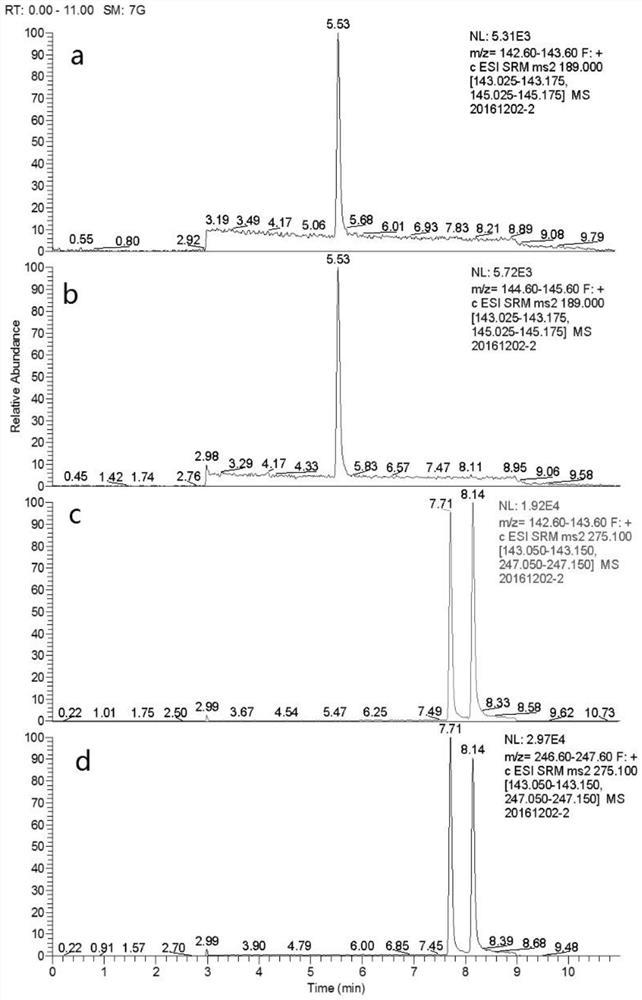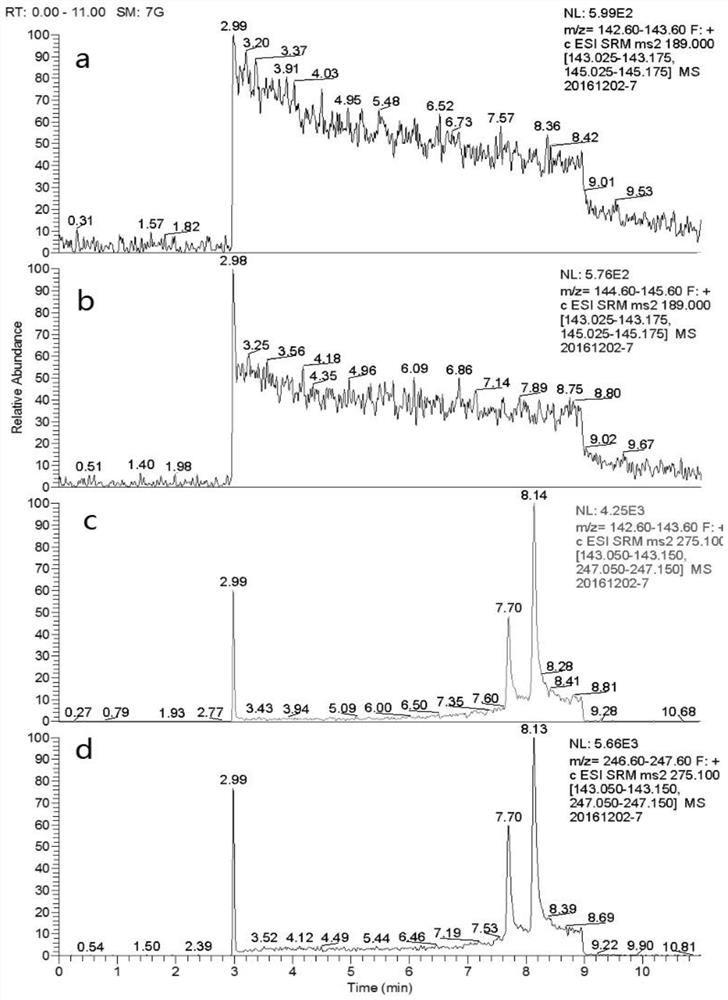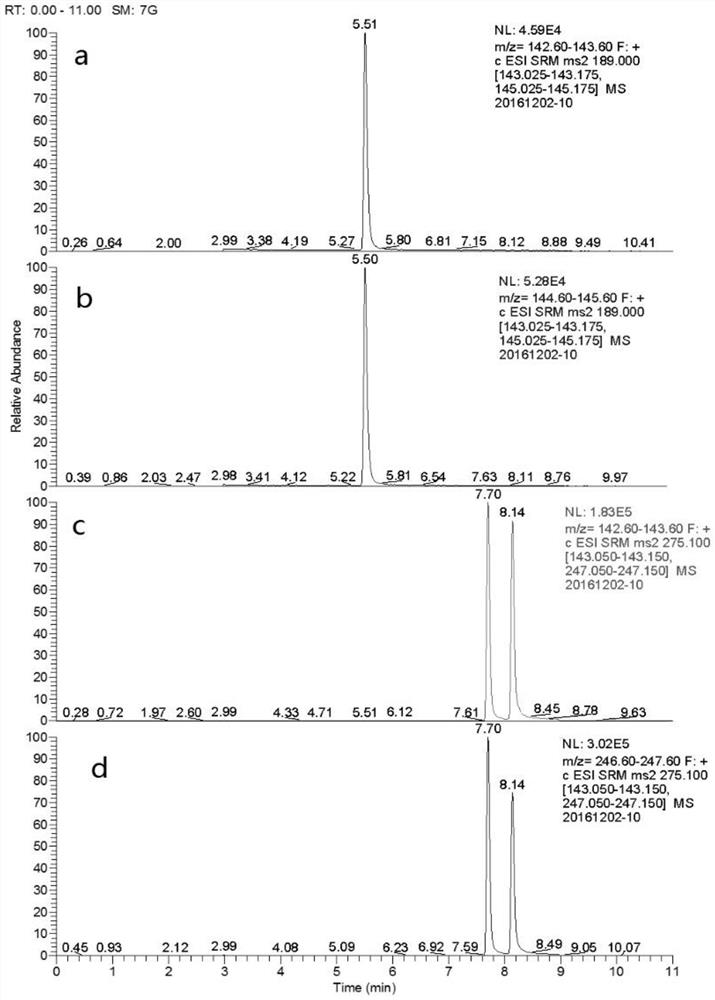Method for determining desoxyquinocetone and 3-methylquinoxaline-2-carboxylic acid in seawater
A technology for removing quinocetone and methyl quinoxaline is applied in the field of pollutant detection in seawater, and can solve the problems of low detection sensitivity and the like
- Summary
- Abstract
- Description
- Claims
- Application Information
AI Technical Summary
Problems solved by technology
Method used
Image
Examples
Embodiment 1
[0112] Acquisition of the standard curve:
[0113] The desdioxoquinone was dissolved in acetonitrile to prepare a desdioxoquinone stock solution with a concentration of 100 μg / mL;
[0114] 3-methylquinoxaline-2-carboxylic acid was dissolved in acetonitrile to prepare a 3-methylquinoxaline-2-carboxylic acid stock solution with a concentration of 100 μg / mL;
[0115] Take 1.0mL dedioxoquinone stock solution and 1.0mL 3-methylquinoxaline-2-carboxylic acid stock solution in a 100mL volumetric flask, and dilute to volume with acetonitrile to obtain dedioxoquinone and 3-methylquinoxaline Phenyl-2-carboxylic acid mixed standard stock solution 1.0 μg / mL;
[0116] Take 10 μL, 20 μL, 50 μL, 100 μL, and 200 μL of the concentration of 1.0 μg / mL dedioxoquinone and 3-methylquinoxaline-2-carboxylic acid mixed standard stock solutions, respectively, and dilute 100, 50, 20, 10 and 5 Times, to obtain desdioxoquinolone and 3-methylquinoxaline-2-carboxylic acid are respectively 10ng / mL, 20ng / mL,...
Embodiment 2
[0122] Limits of detection and limits of quantitation
[0123] According to the 3 times signal-to-noise ratio of dedioxoquinone and 3-methylquinoxaline-2-carboxylic acid, the detection limit of the concentration on the machine is determined, and then converted into dedioxoquinone and 3-methylquinoxaline in seawater The detection limit concentration of phenoline-2-carboxylic acid. The results were: the detection limit of dedioxoquinone was 5 ng / L, and the detection limit of 3-methylquinoxaline-2-carboxylic acid was 5 ng / L.
[0124] According to the 10 times signal-to-noise ratio of dedioxoquinone and 3-methylquinoxaline-2-carboxylic acid, determine the quantitative limit of its concentration on the machine, and then convert it into dedioxoquinone and 3-methylquinoxaline in seawater The limit of quantitation of -2-carboxylic acid. The results were: the limit of quantification of dedioxoquinone was 10 ng / L; the limit of quantification of 3-methylquinoxaline-2-carboxylic acid wa...
Embodiment 3
[0126] Method recovery and precision
[0127] The standard solution was added to the blank seawater sample to make 3 groups of standard addition samples with different concentrations, and 6 samples of each concentration were measured in parallel. The recovery rate and precision of the method were calculated. The results are shown in Tables 1 and 2.
[0128] Table 1 The recovery and precision test results of 3-methylquinoxaline-2-carboxylic acid
[0129]
[0130] As can be seen from Table 1: when the addition amount of 3-methylquinoxaline-2-carboxylic acid was 10.0~200.0ng / L, the rate of recovery of 3-methylquinoxaline-2-carboxylic acid was 72.3~91.8 %; the relative standard deviation within the batch was less than 8%, and the relative deviation between batches was less than 6%.
[0131] The rate of recovery and the precision test result of table 2 dedioxoquinone
[0132]
[0133] It can be seen from Table 2 that the recovery rate of dedioxoquinone is between 70.2% and ...
PUM
| Property | Measurement | Unit |
|---|---|---|
| collision energy | aaaaa | aaaaa |
| collision energy | aaaaa | aaaaa |
| recovery rate | aaaaa | aaaaa |
Abstract
Description
Claims
Application Information
 Login to View More
Login to View More - R&D
- Intellectual Property
- Life Sciences
- Materials
- Tech Scout
- Unparalleled Data Quality
- Higher Quality Content
- 60% Fewer Hallucinations
Browse by: Latest US Patents, China's latest patents, Technical Efficacy Thesaurus, Application Domain, Technology Topic, Popular Technical Reports.
© 2025 PatSnap. All rights reserved.Legal|Privacy policy|Modern Slavery Act Transparency Statement|Sitemap|About US| Contact US: help@patsnap.com



